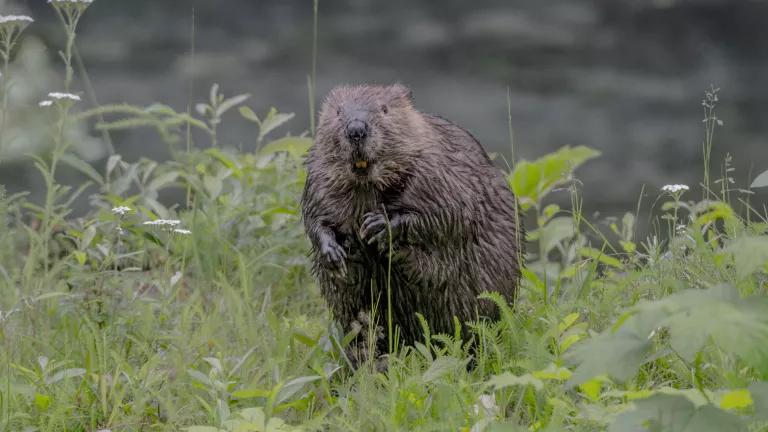Restoring Riverscapes and Beavers in the West
BLM has a ripe opportunity to dramatically increase the health of its landscapes by managing its riverscapes as a critical piece of natural infrastructure.

A healthy riverscape on the South Platte River (CO)
Mark Beardsley, EcoMetrics
Lands managed by Bureau of Land Management (BLM) are often misunderstood, and their conservation values underestimated. However, as the single largest federal public land manager, BLM has a critical role to play in addressing two inter-related crises—biodiversity collapse and climate change. Key to fighting both challenges is the restoration and protection of freshwater resources. And, now, with the passage of the Infrastructure Investment and Jobs Act, BLM has access to new funding it can use to invest in natural infrastructure, restoration, and building climate resilience.
Much of the land managed by BLM is in semiarid landscapes. In such landscapes, riparian-wetland and aquatic areas occupy a small portion of the broader landscape (historically 5-15%; today 1-2%), but have a disproportionately beneficial influence on wildlife, vegetation, and water resources. While the footprint of western riparian areas and wetlands has been significantly reduced, it supports around 80 percent of the area’s biodiversity. In addition to providing habitat for myriad species of plants, fish, and wildlife; healthy streams and their associated wetlands provide ecosystem services such as clean drinking water and pollination; reduce the effects of wildfires, floods, and drought; and are key to the vitality of local economies and communities.

Dixie Creek, near Elko, NV was restored through a collaboration of BLM land managers, ranchers, and sportsmen and women.
Little Wild
Riverscapes are Natural Infrastructure
Riverscapes are the connected floodplain and channel habitats that together make up valley bottoms. Unfortunately, in many watersheds, stream channels are carved into deep trenches and disconnected from their floodplains, leading to less available water, poorer water quality, lower biodiversity, and ultimately less drought resiliency. BLM manages more than 250,000 miles of streams and rivers, roughly eight percent of the nation’s riverscapes and two percent of the ones that flow year-round. Because of this, BLM has a ripe opportunity to dramatically increase the health of landscapes it is entrusted to steward by managing its riverscapes as a critical piece of natural infrastructure fundamental to protecting biodiversity and adapting to climate change. Put another way, with some effort and investment, BLM can return life to 70 to 80 percent of its rivers and streams that now look and function like dried-out sponges.
Kickstarting Natural Processes
To accomplish this, BLM should prioritize investing in a restoration technique known as low-tech, process-based restoration (LTPBR) to improve the condition of and expand riverscape habitat on the lands it manages. While LTPBR sounds complicated, it really isn’t. It is the practice of using wood, beaver dam analogs, and other natural inputs to divert flows, widen stream channels, and trap stream sediment to begin the process of moving water back onto the floodplain and recharging groundwater. Once natural processes are kickstarted, beavers can return to streams to sustain and expand riverscape restoration. By investing in such techniques, the BLM can restore degraded stream channels into healthy, functioning riverscapes that will yield greater and more consistent benefits in water quantity, water quality, habitat for terrestrial and aquatic species, recreation, and carbon sequestration, while simultaneously increasing resilience to droughts, floods, and fires.

Four Key Steps to Restore Riverscapes
Restoring riverscapes on public lands is a long-term strategy, but the time to start is now. The most pressing urgency is posed by the immediate threats and impacts of the climate crisis. Secondly, in November, Congress passed the Infrastructure Investment and Jobs Act which includes five years of funding for BLM and other federal agencies to invest in high-impact outcomes such as restoring our natural infrastructure. To increase the scale and impact of riverscape restoration to meet the scope of degradation and need, the BLM should:
- Reimagine the role riverscapes can play as vital, natural infrastructure.
- Prioritize riverscape restoration on BLM-managed lands and partner with states, tribes, and local stakeholders to create good paying, private, non-profit, and public sector restoration jobs in rural and tribal communities.
- Use infrastructure and other relevant funding sources to restore riverscapes and the many benefits that come with them. BLM should invest where: (a) conditions are right for low-tech, process-based restoration, (b) ecological and hydrological benefits are high, and (c) partner interest and stakeholder engagement is high.
- Incorporate riverscape restoration into pending regulatory changes, resource management plan revisions; as well as strategies to advance the America the Beautiful Initiative, address sage grouse conservation and wildland fire mitigation and restoration.
Let's Start (or Kickstart, as the Case May Be) the Process
It’s time to invest in our natural infrastructure as one of our key tools for fighting biodiversity loss and climate change. The Infrastructure Investment and Jobs Act provides a major opportunity to do just this on America’s public lands. BLM should use the next five years to establish a compelling and successful track record that helps the public and Congress see inspiring examples of what’s possible when strategic investments in our public lands are made in concert with natural processes. The clock is ticking.




